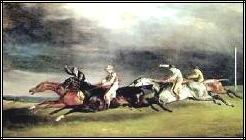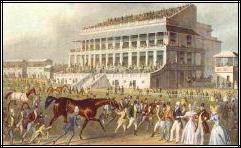|
|
Gazeteer: Race Courses of Great Britain and Ireland
 |
|
Geographic Listing Ordered by County and Month | |
Compiled and Written by Nigel Pullen |
|
|
|
Horse racing has been recorded at Epsom Downs since the 17th Century. The location was a popular spa, providing the famous "Epsom Salts." The race programmes at Epsom were traditionally comprised of races run in two to four mile heats. In 1778, the (12th) Earl of Derby proposed the running of a single race over one and a half miles for three-year-old filles, to be held on the grounds of "The Oaks," a country house leased by the Earl. The first running of this race took place in 1779, and the following year a race open to both colts and fillies was held, the first Epsom Derby. With the exception of the years during the two world wars, Epsom's turning, up-and down-hill courses have been in continuous use ever since.
|
Below: Left--1821 Derby won by Sir Joshua; Right-1836 Derby winner Bay Middleton with grand stand behind; bottom: Epsom Downs 1846 |
|
|
|
|  | | |  |
|  |
|
| CITY AND SUBURBAN HANDICAP |
|
|
|
First Run: 1851
Month Run: April
Venue: Epsom, Surrey, England
Distance: 1 mile 2 furlongs
Status:Handicap for 4 year olds and upwards |
|
|
This is a race that in former times was regularly contested by a high-class field. For instance, in 1854, the filly Virago, had an unorthodox preparation for the forthcoming 1000 Guineas, by completing an unusual double of winning this race and the mile longer Great Metropolitan at the Epsom Spring Meeting. Obviously a tough customer, Virago actually won twice more at York later in April, before triumphing in the 1000 Guineas itself in early May. Unfortunately the race now longer attracts horses of that calibre, and is now just another ordinary mile and a quarter handicap. |
|
|
|
|
First Run: 1846
Month Run: April
Venue: Epsom, Surrey, England
Distance: 1 mile 4 furlongs
Status: Handicap for 4 year olds and upwards |
|
|
In 1846, Epsom's clerk of the course set out to upgrade the Spring Meeting by persuading businesses and clubs in the London area to contribute towards the prize money for a new race. He successfully raised the sum of £300 for the purpose, and so the Great Metropolitan Handicap was born, making it one the first races to be sponsored. Before 1985 this race was unique in the English racing calendar. Then raced over two and a quarter miles, it started at the winning post and ran in the reverse direction of the Derby course for about 3 furlongs, where it turned right across the in-field of the main track, rejoining the Derby course just over a mile from home. Because the in-field of the course was downs land, and open to the public, it became increasingly difficult to maintain it in good racing condition, so in 1985 the race was reduced to a mile and a half and run over the Derby course itself. The unique character of the race was consequently lost, and it has now become just another handicap. |
|
|
|
|
First Run: 1902
Month Run: June
Venue: Epsom, Surrey, England
Distance: 1 mile 4 furlongs
Status:Group 1 for 4 year olds and upwards |
|
|
Founded in 1902 to mark the coronation of King Edward VII, the Coronation Cup replaced the previously run Epsom Cup, which had also been opened to three-year-olds. The first running took place on 5th June 1902, and saw Lord Wolverton's four-year-old colt Osboch triumph over the previous year's Epsom Derby hero Volodoyovski. Run over exactly the same course as the Epsom Derby Stakes, the Coronation Cup is now contested by the leading middle distance older horses. |
|
|
|
|
First Run: 1780
Month Run: June
Venue: Epsom, Surrey, England
Distance: 1 mile 4 furlongs
Status: Group 1 for 3 year olds |
|
|
History has it that Earl of Derby and Sir Charles Bunbury tossed a coin to decide the name of the race. The coin landed in Lord Derby's favour. There were 36 subscribers for the original event at 50 guineas each (half forfeit), and of these a total of 9 horses went to post on 4th May 1780. Sir Charles Bunbury may have lost the toss of the coin, but he gained ample consolation, for his colt, Diomed, won this inaugural running.
In 1784 was transferred to the Orbicular, or Cup, Course, along with the Oaks, and the distance increased to a mile and a half. Thenceforth, it was run on the same course as the Oaks, and, like the Oaks, was run at Newmarket during the war years (1915-1918 and 1940-1945).
The Derby course is unique among racecourses and is the supreme test of the thoroughbred. The track is left-handed in the shape of a horseshoe. From the start, 360 feet above sea level, there is a slight right-handed bend and a rise of some 134 feet until the top of the hill is reached at half-way. There is then a sweeping left-hand descent to Tattenham Corner, in which the ground drops another 34 feet, into the finishing straight of 3 furlongs. The downhill gradient continues, falling by another 50 feet until about 100 yards from the finish where it rises again by 10 feet. In addition to this, there is a camber across the finishing straight leaning towards the inside rail, which, at the winning post measures about 6 feet. |
|
|
|
|
First Run: 1779
Month Run: June
Venue: Epsom, Surrey, England
Distance: 1 mile 4 furlongs
Status: Group 1 for 3 year old fillies |
|
|
The turning point in Epsom fortunes as a racecourse came in 1773, when the 12th Earl of Derby took over the lease of "The Oaks," a country house on the outskirts of Epsom. The Earl often entertained a large party of friends there, when acting as a steward at the meeting, and it was at one of these gatherings during the 1778 May meeting, that the idea of the Oaks Stakes was first conceived. At that time the race programme consisted of races run in heats of two or four miles, and it was proposed that a single race over one and a half miles for three-year-old-fillies would enhance the meeting the following year.
This new race was named after Lord Derby's leased house, and was run for the first time on 14th May 1779, attracting 17 subscribers at 50 guineas each. Twelve fillies went to post, and appropriately enough, the winner was Lord Derby's Bridget.
Up until 1783 the race was run over the last 12 furlongs of the original four-mile course. It was then moved to the Orbicular, or Cup, Course in 1784. In 1848 the race was transferred to what was known as the New Course, which followed the track of the current course, apart from the first furlong. Finally, in 1872, the race moved to the present location. The bends and gradients at Epsom make it a tough test for the thoroughbred.
During the first and second World Wars (1915-1918 and 1940-1945), the Oaks was transferred to the July Course at Newmarket, and run on the Suffolk Stakes Course there. |
|
|
|
|
First Run: 1886
Month Run: July
Venue: Sandown Park, Esher, Surrey, England
Distance: 10 furlongs
Status: Group 1 for 3 year olds and upwards |
|
|
The first race meeting was held at Sandown Park in 1885, and the following year the clerk of the course, Mr Hwfa Williams, with the support of Mr. Leopold de Rothschild, decided to stage the first £10,000 race ever to be run in England. The idea came to fruition on 23rd July 1886 with the inaugural running of the Eclipse Stakes, named after the great 18th Century racehorse. It was won by the six-year-old Bendigo. The year 1903 saw one of the greatest renewals of the event, when the previous year's Epsom Derby winner, Ard Patrick, defeated the wonderful filly Sceptre, winner of the other four classics in 1902, with the 1903 English Triple Crown winner, Rock Sand, back in third. The Eclipse Stakes is now run in early July, and is the first chance for the classic generation of three-year-olds to take on their elders. |
|
|

